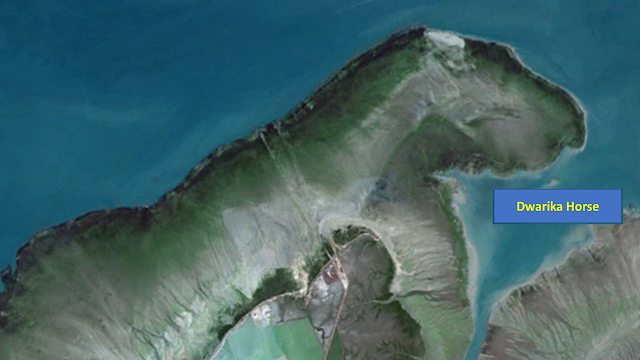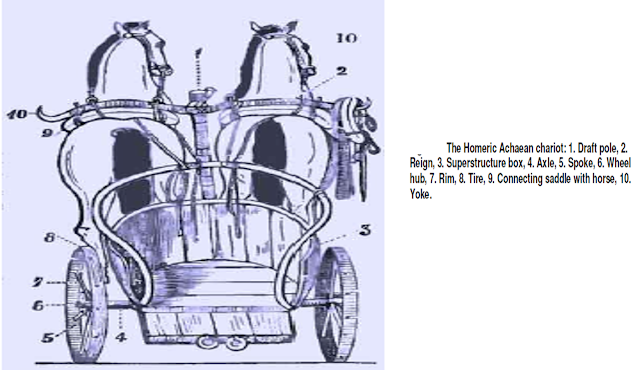The Dwarika Chariot Seal
The wide importance of the saddled horse at Dwarika shows that the Dwarika military was using at a time four horses in the chariot. This was the fast movement car at that time for aggressive battle. The Dwarika Chariot Seal is given here, which is now at Hong-Kong. This Chariot Seal is entirely from the Dwarika, as there is wide use of ceramic in this Chariot Seal. This has the clear implication of the Kurukshetra war, indicating four different but favorite, best and faithful horses of Arjun. Surprisingly Bhagwan Krishna has also four horse drawn chariot. This is showing either the chariot of Bhagwan Krishna or Arjuna. The extensive use of ceramic in the chariot seal make it 100% native to Dwarika. The four horses shown in the chariot seal are similar to the Dwarika horse. This is apparently Krishna and Arjuna in the battlefield built after the MB war 3138 BCE.
The axle and wheel design used in the Chariot Seal has been carried down to Puri. Bhagwan Jagannath Chariots are designed entirely on the model of the chariot seal without the application of any ball bearing. This is the origin of the Indian chariots. The Indian chariots have been widely copied by the Hittites and the Greeks.
The multiple crossbar wheel is an amazing example of the technical innovations by the diffusion of horse draught war chariots. The invention of the wheel was a key factor in the development of cultures. The speed was dramatically improved from one horse to four horses. How Dwarika Chariot was using the lubrication in the wheel and axle. We have to closely watch the wheel ceremony of Jagannath Puri. The lubricant agent introduced in the Jagannath Puri Chariot is entirely Vedic. The Jagannath Puri chariot has carried many ancient Dwarika practices. This is solution from the walnut and cedar. Same lotion is approximated in the Dwarika chariot. Wooden wheels and copper wheels are frequently used in the Dwarika age.
The Dwarika battle chariot is based on weight - wheel ratio. The occupants weight remains above the axle. On the Dwarika Chariot Seal we see Arjuna and Krishna standing in the Chariot pocket. Bhagwan Krishna apparently driving the chariot and Arjuna engaged in the battle with his weapon. The axle end diameter is carefully built. The Sinauli Chariot do not go beyond 1600 BCE. This age is very modern then the age of the Dwarika Chariot Seal which was built in 3100 BCE after the MB war.
This is bogus European thought and more it is the absolute bogusness of the Indian historians and the archaeologists, where in the name of politics, Aryans enter India from Central Asia in 1500 BCE in the riding horses. Such bogusness of the historians and the archaeologists have allowed court in India to take historical matter in their hands and decide the issues according to the Indian Evidence Act 1872.
The Dwarika Horse ( 3200 BCE ) with clear saddle mark on the body is found at Dwarika in one of the Dwarika Ports, which design is based on horse. The same horse quality appears in the Dwarika Chariot Seal. The horse type is same.
The Karnataka Wheel for the Chariot of Bhagwan Krishna is the same as found at the Chariot Seal of Dwarika. The wheel - axle relation is common.
The Bharhut (Madhya PradTesh) panel has again four horse drawn chariot. Same chariot shown on the Dwarika Seal Chariot.
The Acheon Chariot brought the idea from India on developing the wheel axle relation. This is same as found in India
The Homer Acheon Chariot entirely brought the idea from India to develop the wheel axle relation














Comments
Post a Comment